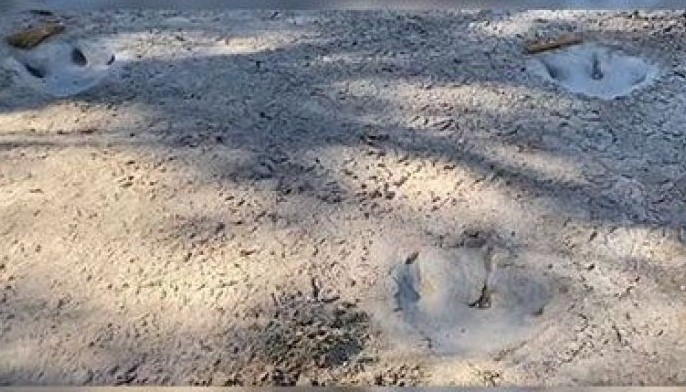MANILA, Philippines — Ancient and historical artifacts and structures recently began resurfacing as plunging water levels due to drought continue to affect parts of Europe, China and the United States.
The latest that made the news are the dinosaur tracks in a state park in Glen Rose, Texas in the United States.
Last week, a "Spanish Stonehenge" dating back to 5,000 BC was seen again in Caceres, Spain while a trio of ancient Buddhist statues believed to be around 600 years old reemerged as the waters of China's Yangtze River continue to recede.
In Serbia, the hulks of 20 German warships that were sunk during the World War II were seen in Prahovo due to the low water level of the Danube River.
The Dinosaur Valley State Park shared on August 17 on its Facebook page that dinosaur tracks have been revealed after the Paluxy river within the park had dried up due to drought. In an email interview with CNN International, park spokesperson Stephanie Salinas Garcia said that most of the tracks belong to Acrocanthosaurus. She said it is a kind of dinosaur that "would stand, as an adult, about 15 feet tall and (weigh) close to seven tons." The other dinosaur species that left tracks on the river was the Sauroposeidon, which she said would be about 60 feet tall and weigh about 44 tons as an adult.
On August 18, Reuters reported that the "Spanish Stonehenge" is officially known as the Dolmen of Guadalperal. It is found in the Valdecanas reservoir which authorities said its water level has dropped to 28% of its capacity.
Dolmens are vertically arranged stones usually supporting a flat boulder. There are other dolmens in other parts of Western Europe but little is known about who erected them. There have been human remains found near dolmens, prompting many to believe that these megalithic stones were tombs.
These dolmens have only been seen in full four times, the report said. German archaeologist Hugo Obermaier discovered these in 1926, but these were again submerged after the flood in 1963.
In August 20, three statues in China believed to be from the Ming and Qing dynasties, emerged at the highest point of the island reef called Foyeliang.
Apart from less rainfall with the Yangtze basin seeing less of it by 45% lower than its normal since July, the region is expected to have high temperatures to persist for another week. State broadcaster CCTV has reported that as many as 66 rivers across 34 counties in Chongqing have dried up.
According to the English language web site of China News Service, ECNS.com, Chongqing is suffering through its worst heat wave since 1961. Temperatures have reached 45 degrees Celsius and forecasts have estimated that from July 1 to August 25, high temperature days in the southwestern province may reach 40.8 days. Several wildfires have been reported in mountain and forest areas in the province's Jiangjin, Dazu, Tongliang, and Banan districts.
Yangtze is the longest river in Asia and the third longest in the world after the Nile and Amazon rivers.
Meanwhile, the German warships were among the hundreds left along the Danube by the retreating Nazi Black Sea fleet in 1944, the agency said in a report. The Danube River runs through 10 countries that include Germany, Austria, Slovakia, Hungary, Croatia, Serbia, Romania, Bulgaria, Moldova and Ukraine.
RELATED: UFO again? Monolith disappears from US, another found in Romania


